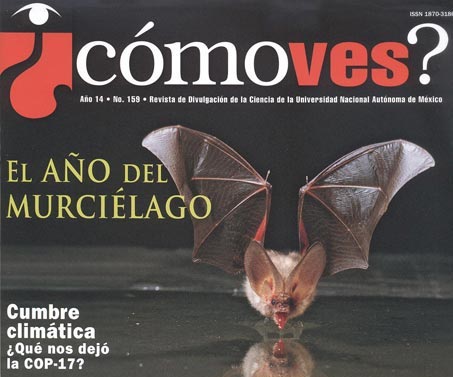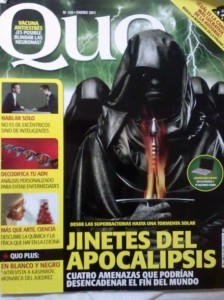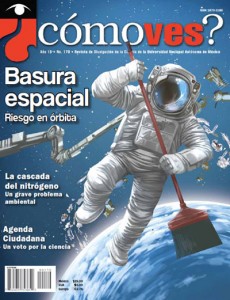 Several weeks ago I was invited to sit in on a fascinating workshop on journalism. Hosted by the Mexican Society for Science and Technology Communication (SOMEDICYT), it was a collection of science writers from Mexico and abroad gathered together to discuss the definition of science journalism.
Several weeks ago I was invited to sit in on a fascinating workshop on journalism. Hosted by the Mexican Society for Science and Technology Communication (SOMEDICYT), it was a collection of science writers from Mexico and abroad gathered together to discuss the definition of science journalism.

It was the kind of philosophical dialogue that you don’t get to have too often as a working journalist, concerned about selling stories and hitting deadlines. But it’s a crucial topic, especially in Mexico. Despite being a massive market with a (mostly) common language, Latin America is virtually overlooked by the wider science writing community.
On the one hand in countries like Mexico, Colombia, Argentina, and Chile (skipping Brazil for now because I am talking about Spanish-speaking science writing) have robust research endeavors. On the other, most of the mainstream “science” magazines are simply embarrassing. The two biggest, Quo and Muy Interesante, trade between covers between aliens, conspiracy theories, and the ever-popular Jesus-in-crisis. About half of the material is legitimate science and the other – well – I really liked the exposé on wolfmen.

But here’s the thing – if you read the Spanish versions of these mags (as in, from Spain itself) there are no aliens or crucifixion stories – just straight science writing. In other words, the publishers of these magazines think so poorly of the Latin American readership, they are convinced that the only way to sell them science is to tart it up like some grocery aisle tabloid.
I am convinced that this is simply not true. National Geographic’s Spanish version doesn’t stoop to such levels and they have brisk sales. Plus, most Mexicans I talk to are embarrassed by these magazines and those who want good science writing look to Scientific American, New Scientist, or whatever foreign outlets they can get.
Like so many emerging markets, Mexico today needs good science writing and I believe it’s hungry for it. But it needs stories with a Mexican flair by the people who live there – rather than, well, hacks like me. Or worse, people who have never been to the country (if it gets covered at all). Therefore, much of the conversation at the SOMEDICYT workshop focused on how Mexican science writing can improve. I imagine similar conversations in India, Brazil, China, and South Africa. People talked about access to existing outlets and antiquated media like general interest newspapers. There was some familiar fretting about how to slice up the existing pie and how to get the attention of editors who are afraid of science stories.

But with such a massive underserved population, Latin America needs to stop worrying about its pitiful existing pie slices and just expand the whole thing. The question should not be “How can we get more science writing in LatinAmerica,” but rather “What should the next generation of Latin American science writing look like?” One that is is smart, creative, and distinctly of its own culture. When I think of the future of English-language science journalism, I think of NatGeo’s tablet edition, Mental Floss, I Fucking Love Science, Download the Universe and hell, xkcd and Logicomix while you’re at it.
To say that just because Mexico is a Catholic country its science writing needs focus on virgin births and miracles in order to connect with the common man is either cynical or just plain manipulative. Having now spend a moderate amount of time with poor fishermen, I can tell you that they have the same questions about the oceans, stars, and medicine that anyone has who doesn’t read Nature.
One Mexican magazine that makes a responsible effort to inform the public about science is Cómo Ves?, a magazine based out of Mexico’s largest university, UNAM. Now, as a institutional magazine, Cómo Ves? may not be the future of science writing, but it treats its readers like adults who want simple, informative, and accurate science. Its editor, Estrella Burgos, is a regular at science writing meetings and thinks deeply about these issues (and, full disclosure, has become a friend).
A couple years ago, Burgos realized that the magazine had picked up a readership in, of all places, Mexican prisons. She received two emails that in my mind answer what it is that we science writers do. One was from an inmate thanking her for letting him, if just for a moment, see the wide world from inside his dismal cell. The magazine lifted him out of his rut and allowed him to presumably soar with ospreys, travel near light speed, and dive to the bottom of the ocean.

The second was from an inmate who had read the magazine and related it to his own situation.
My interest in food is related to where I’m currently living and what I’m watching. Over the last few months they have reduced our rations to an offensive quantity – without even mentioning the quality – nearly every dish of chicken that is served to us has viscera, cartilage and bits of crushed bones as if instead of trimming the chicken, they put it in a giant blender in order to achieve a texture and disagreeable color that is almost as horrible as its odor.
My point is that since they “put us on a diet” all the inmates are in a very bad mood, we go about our activities with apathy, and even basic civility is disappearing little by little and there have been more suicide attempts. I don’t know who could make do research on this, but perhaps you may be interested in showing that even nutrition is part of social rehabilitation.
To transport, illuminate, and educate – that is our job. And every now and again to shine the light of science on a few dark corners. And if two prisoners rotting in a Mexican prison can get hooked on it then a lot more around the world can too. Mexico and Latin America need to take a page out of India’s playbook and grow the pie. Bring in not just the people who already like science, but the people who don’t yet know how much they love it yet.
I don’t know what the future of science journalism is in Mexico. I know I’m not the one to who will create it. But when it arrives – be it online, on TV, or just on the street corner – it’s going to change the entire playing field. Buckle up and brace yourself.

One thought on “Growing the Science Writing Pie”
Comments are closed.